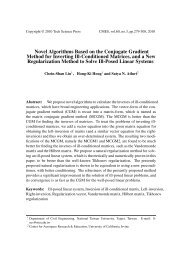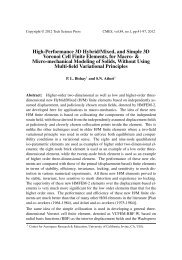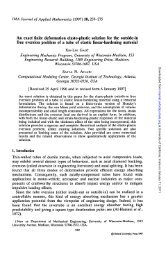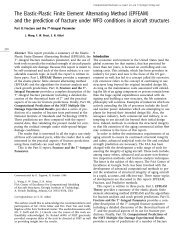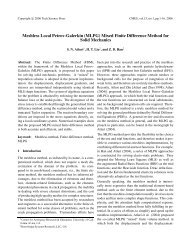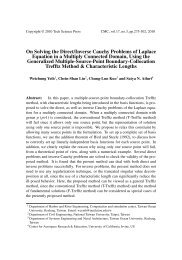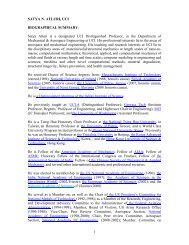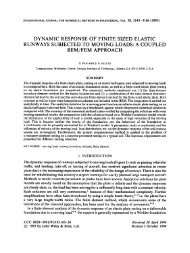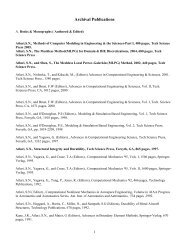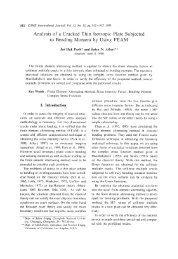on the hybrid stress finite element model for incremental analysis of ...
on the hybrid stress finite element model for incremental analysis of ...
on the hybrid stress finite element model for incremental analysis of ...
Create successful ePaper yourself
Turn your PDF publications into a flip-book with our unique Google optimized e-Paper software.
1188 SATYANADHAM ATLURJ<br />
limit-load type and <strong>the</strong> deflecti<strong>on</strong> mode always follows <strong>the</strong> half-sine wave type. For<br />
C,/I?J(AII) > J(5.5) and C, = 0 <strong>the</strong>re exists, at sufficiently high loading, two branches in<br />
<strong>the</strong> exact soluti<strong>on</strong>, <strong>on</strong>e symmetric and <strong>the</strong> o<strong>the</strong>r asymmetric. The Iatter corresp<strong>on</strong>ds to a<br />
bifurcati<strong>on</strong> buckling mode. When <strong>the</strong> initiai shape <strong>of</strong> beam is such that C2 # 0. <strong>the</strong> prebuckting<br />
de<strong>for</strong>mati<strong>on</strong> c<strong>on</strong>tains both symmetric and asymmetric comp<strong>on</strong>ents and <strong>the</strong><br />
buckling phenomena is a limit load type.<br />
In <strong>the</strong> example problem, using <strong>the</strong> <strong>analysis</strong> presented earlier, <strong>the</strong> length s al<strong>on</strong>g <strong>the</strong><br />
beam in c<strong>on</strong>figurati<strong>on</strong> C, (be<strong>for</strong>e <strong>the</strong> additi<strong>on</strong> <strong>of</strong> first load-increment) is taken as <strong>the</strong><br />
c<strong>on</strong>vected curvilinear coordinate. C<strong>on</strong>sidering c<strong>on</strong>figurati<strong>on</strong> CN. if c#~ is <strong>the</strong> angle between<br />
<strong>the</strong> base vector g and s-axis, it can be shown that <strong>the</strong> equiIibrium equati<strong>on</strong>s <strong>for</strong> <strong>incremental</strong><br />
Piola-Kirch<strong>of</strong>f <strong>stress</strong>es (per unit area in C,), analogous to equati<strong>on</strong> (39), become<br />
and<br />
dAN di$ dM<br />
-fdsds=<br />
ds .<br />
-Aps<br />
(70)<br />
dZAM d4<br />
ds2+zAN<br />
= -AP&<br />
(71)<br />
where N, is <strong>the</strong> initial l<strong>on</strong>gitudinal <strong>stress</strong> resultant in C,V, pS and pn are <strong>the</strong> nth tangential<br />
and normal (to beam) load increments, and AN and AM are <strong>the</strong> <strong>incremental</strong> <strong>stress</strong> resultant<br />
and <strong>stress</strong> coupie respectively in <strong>the</strong> nth stop. The functi<strong>on</strong>al x,* analogous to equati<strong>on</strong> (38)<br />
<strong>the</strong>n becomes,<br />
@=<br />
ANAu+AVAw+AM<br />
where n is <strong>the</strong> number <strong>of</strong> <strong>element</strong>s, I, <strong>the</strong> length <strong>of</strong> <strong>the</strong> <strong>element</strong>, and b, refers to <strong>the</strong> two<br />
ends <strong>of</strong> <strong>the</strong> beam, and AV is <strong>the</strong> <strong>incremental</strong> transverse shear resultant at <strong>the</strong> ends <strong>of</strong> <strong>the</strong><br />
<strong>element</strong>. in <strong>the</strong> numerical soluti<strong>on</strong>, three generalized displacements. AU, Aw and dbwids<br />
are used at each node. The homogeneous soluti<strong>on</strong> (denoted by subscript H) corresp<strong>on</strong>ding<br />
to equati<strong>on</strong>s (70,711 can be seen to be,<br />
AN, = /3,cosd,+&sinrb<br />
AMH = B3 +<br />
i<br />
Cpl sin i ,!& cos $) ds.<br />
0<br />
It is observed that in more complicated problems such as plates and shells, recourse can<br />
be made to <strong>the</strong> so-called “static-geometric analogy” to find <strong>stress</strong> functi<strong>on</strong>s that identically<br />
satisfy <strong>the</strong> linear <strong>incremental</strong> homogeneous equati<strong>on</strong>s such as in equati<strong>on</strong> (39). In order<br />
to obtain <strong>the</strong> particular soluti<strong>on</strong>, <strong>the</strong> given loads Ap, and Ap, are interpolated trig<strong>on</strong>ometrically<br />
from <strong>the</strong>ir respective values at <strong>element</strong> nodes; and Aw in <strong>the</strong> <strong>element</strong> is interpolated<br />
by a four-parameter trig<strong>on</strong>ometric functi<strong>on</strong> using <strong>the</strong> vaiues Aw and ddwids at<br />
each node <strong>of</strong> <strong>the</strong> <strong>element</strong>. The trig<strong>on</strong>ometric <strong>for</strong>m <strong>of</strong> <strong>the</strong> particular soluti<strong>on</strong>, though<br />
cumbersome in <strong>for</strong>m. can be obtained easily, in <strong>the</strong> <strong>for</strong>m <strong>of</strong> equati<strong>on</strong> (41), and is not<br />
recorded here.<br />
(73)




